By Car
A sharp U-turn on Mulholland
March 3, 2011
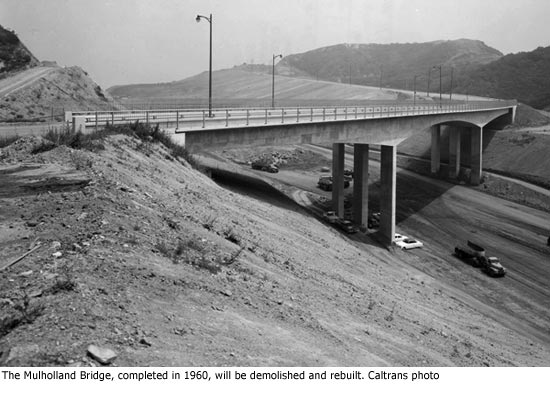
In the end, it was a bridge too far.
A short-lived plan to build a new Mulholland Bridge before tearing down the existing one as part of the I-405 Sepulveda Pass project has been scrapped, less than six months after it was announced to cheers from many in the project’s Community Advisory Committee. Project officials instead are reverting to their original plan of demolishing and rebuilding the existing bridge in two stages—although that’s expected to be costlier and more disruptive to traffic.
It’s also expected to take longer. Mike Barbour, who’s heading up the project for Metro, says that even though the freeway project as a whole remains on track to largely finish by May or June, 2013, the about-face will likely delay the Mulholland Bridge’s reopening for up to three months.
The change of plans comes after a Los Angeles city design review board weighed in on the project, asking for modifications and pushing Metro to go back to the drawing board to create an “extraordinary,” visually striking redesign of the bridge.
At the same time, the Brentwood Residents Coalition filed a series of objections to the project, arguing that the new-bridge plan would hurt the Mulholland corridor’s scenic quality and violate the California Environmental Quality Act if it went forward without a comprehensive environmental review. Letters expressing concern also came from the Bel Air Skycrest Property Owners Association and the Santa Monica Mountains Conservancy.
Their concerns included fears that the new configuration would interfere with the wildlife corridor around the bridge and break up Mulholland Drive by creating a “T-intersection” at the bridge, chopping the road into two segments.
The creation of an all-new Mulholland Bridge would break “the sinuous, continuous line of the beautiful and historic mother road,” Lois Becker, president of the Bel Air Skycrest group, wrote in a letter to the city’s Mulholland Scenic Parkway Specific Plan Design Review Board.
Toni Lewis, an architect on the design review board, said members had not set out to block the new-bridge plan and had made reasonable recommendations to Metro that could have been worked through.
The look of the proposed new bridge, developed in consultation with the project’s Community Advisory Committee, had been intended to mimic the existing structure, completed in 1960. But Lewis said too little consideration had been given to designing something better to befit one of the city’s landmark roadways.
“This is something that’s important and we’re treating it like the overpass at Overland, which it’s not,” she said. “I just thought that it was a total missed opportunity to leave something [the city] could be proud of.”
Metro said the design panel’s recommendations, along with concerns that it might be sued by the residents’ coalition, prompted it to reverse course rather than confront potential delays in court and in the design process.
“Unfortunately, we don’t have the luxury of time,” Yvette Rapose, Metro’s community relations manager for the project, said in a Feb. 25 letter to interested parties. Her letter said the agency was doing so even though it was confident that it had been on “firm legal ground” and would have prevailed in a court fight.
The $1.034 billion project is a Metro-Caltrans collaboration to add a 10-mile northbound carpool lane to the 405, along with other improvements. As part of the design-build process, Metro has been regularly meeting with the project’s Community Advisory Committee, made up of representatives from residents’ groups in the surrounding areas.
The idea of minimizing disruption by building a new Mulholland Bridge before knocking down the old one grew out of a meeting with community members last summer, and was supported by many on the advisory committee, particularly those from Encino and Sherman Oaks.
“I think it’s unfortunate that the best solution didn’t come out of the process,” said Barbour, who’d previously estimated that the new-bridge approach on Mulholland could have saved from $4 million to $10 million. He said the majority of the project’s advisory committee members had favored the construction of a new bridge. “A lot of people were supportive. They just weren’t as vocal as the people who were non-supportive.”
“The long and the short of it is: here we are back at square one,” said Laurie Kelson, a member of the Community Advisory Committee, as well as vice president of the Encino Neighborhood Council and chair of its traffic and transportation committee. Kelson had supported the idea of building a new bridge before tearing down the old as a better way to ensure good emergency response times in the heavily-traveled area and to lessen the overall traffic impact of construction.
She said the process should have given more weight to the opinions of those who live closest to the affected area. “There’s something wrong with the process,” she said. Community representatives from “each segment of this project should really be making the more important decisions about their segment.”
Since the challenge to the new-bridge plan also came from within the Community Advisory Committee, there have been some tensions within the group. But nobody seems to feel that any bridges have been permanently burned. “Did I wish they never started this? Absolutely,” Kelson said, of the committee’s dissenters to the plan. “But certainly there are a lot of good people to work with.”
Wendy-Sue Rosen, a member of the Community Advisory Committee and also president of the Brentwood Residents Coalition, which challenged the new-bridge plan, predicted that the advisory committee would be able to put the differences of opinion behind them.
“We are all strong advocates and disagreement is part of the process. But we pull together when necessary for a common goal,” Rosen said in an e-mail. “I don’t think that the differences of opinion over the Mulholland Bridge will make it harder to work collaboratively with each other or with Metro to ensure the project moves forward in the least disruptive manner.”
Posted 3/3/11
Wilshire 405 flyover ramps coming
December 8, 2010
Given the dismal state of Westside traffic, it’s been a long time since anybody was able to fly through the intersection of Wilshire Boulevard and the 405.
But someday people will be able to fly over it.
Two new flyover ramps are part of an ambitious new phase of the 405 Sepulveda Pass improvements project that’s currently projected to begin as early as February. The usual no-pain-no-gain equation applies, however, and each of the existing Wilshire ramps is expected to be closing for periods that could range from 14 days to three months so the work can take place. Detours and many other details of the construction still are being worked out.
The work promises to bring a new layer of temporary suffering to an area that already experiences some of the region’s worst traffic.
When completed, the new ramps, or loops, are expected to significantly improve the flow of traffic onto and off the freeway. Currently, vehicles trying to get off the freeway onto Wilshire must jockey with other vehicles entering the freeway. Under the new configuration, shown in the graphic below, the on ramps and off ramps would be completely separate.
The Wilshire flyover ramps have been the subject of previous speculation, including this on LA Observed. The plans will be sketched out for the public, among many other matters, at the project’s quarterly community meeting on Thursday, Dec. 9, from 6 p.m. to 8 p.m. in the Mirman School auditorium.
An overview of the Wilshire improvements also was included in last month’s Community Advisory Committee briefing, which is available here and will be repeated for anyone who’s interested at the end of the meeting on Thursday.
The Sepulveda Pass project will add a 10-mile northbound carpool lane to the 405 and rebuild three overpass bridges, along with other improvements. It is expected to be finished in 2013.
Posted 12/8/10
Skirball Bridge demo—and detours—begin
October 12, 2010
Getting over the Sepulveda Pass is going to be trickier than usual over the next five nights.
Demolition work on the north side of the Skirball Center Drive Bridge over the 405 Freeway is set to begin tonight, requiring full closure of the freeway between the hours of 9 p.m. and 6 a.m. The after-hours work is expected to continue for five consecutive nights.
Metro has assembled a fact sheet on the Skirball Bridge segment of the project, along with construction information and detour maps.
The bridge is one of three affected by the Sepulveda Pass Improvements Project to build a 10-mile northbound carpool lane on the 405 Freeway. Work on the first, the Sunset Bridge, got underway in July. Metro officials said recently that community concerns about the handling of the third bridge, at Mulholland Drive, has led to a rethinking of that part of the process. Unlike the other bridges, which are being torn down and rebuilt in segments, the Mulholland Bridge now is expected to be torn down all at once after a new replacement bridge is constructed nearby.
Posted 10/12/10
Updated 10/15/10: That was fast. Contractors made quick work of demolishing the north side of the Skirball Bridge over the 405, finishing in three nights instead of the expected five. They’ll be back in a month for two nights of abutment demolition. The rebuilding is expected to take seven months. Then the process will begin all over on the bridge’s south side.
Community wins 405 bridge change
September 29, 2010
Neighborhood traffic concerns—and the potential for saving millions in construction costs—have prompted a radical rethinking of plans to bring down the Mulholland Bridge over the 405 Freeway.
Instead of demolishing and rebuilding the 1959 structure—one of three bridges targeted in the 405 Sepulveda Pass project—workers instead would construct an entirely new Mulholland overpass just south of the current bridge. Coming from the west, drivers would enter the new bridge in the same place they do now, then angle slightly south across the freeway before ending up on Skirball Center Drive. Only after the new span was completed would the old one come down, thus reducing traffic-related inconvenience during construction.
Adopting the new approach is “about 99% sure,” said Mike Barbour, who is heading up the project for the Metropolitan Transportation Authority. He estimates the new method would save between $4 million and $10 million, most of that due to a more straightforward, single-phase building process and a more streamlined approach to temporarily relocating utilities.
The impetus to take another look at the construction plan grew out of meetings this summer with community activists concerned about how dismantling and rebuilding the Mulholland Bridge would affect traffic in the area, home to many educational and religious institutions.
There was applause when the new approach was announced at a recent meeting of the project’s Community Advisory Committee. The group was convened to provide input on the $1.034 billion project, a partnership between Metro and Caltrans that will create a 10-mile northbound carpool lane on the 405, along with other improvements.
“This group of decision-makers is actually listening to the public,” said Richard H. Close, president of the Sherman Oaks Homeowners Association and a member of the advisory committee, who was not at the recent meeting but took part in an earlier session where community concerns about the Mulholland Bridge were discussed. “They’re willing to redesign and solve a problem. It’s a much more collaborative process with the MTA than with other agencies.”
“On other projects, we’ve been told, ‘we are the experts.’” That may be true from an engineering standpoint, he said, but people who live in the area have an invaluable perspective, too: “We know traffic flow.”
He said Metro’s decision to take another look “is somewhat historic, especially on a transportation project.”
Still, other community concerns linger, many relating to the bridge at Skirball Center Drive, where demolition work on the northern side of the structure is slated to begin on October 12. Project plans currently call for freeway on- and off-ramps to be redirected onto Sepulveda Boulevard, rather than directly onto the bridge, as they are now. Residents say they fear the change will create traffic problems on Sepulveda.
“There are a lot of issues with the Skirball Bridge,” said Laurie Kelson, an advisory committee member and chair of the Encino Neighborhood Council’s traffic and transportation committee. “Our community does not want the ramps moved.”
Barbour said those concerns are being reviewed and alternatives are being evaluated. But he said he doesn’t see “a win/win at this point” regarding the Skirball ramps, given what the community wants and what traffic engineers say is needed for improved traffic flow.
Some also have posed questions in recent days about what a new Mulholland Bridge would look like, said Ron Macias, a Metro community relations officer. A 2007 Caltrans assessment described the current structure as an historic example of transportation engineering that “exemplifies the minimalist or modernist aesthetics of the period.”
And there are those, like Louis Krokover, president of the Encino Neighborhood Council and a 3rd generation builder, who argue that the Skirball and Mulholland bridges don’t need to be replaced at all.
Officials on the project say that building a wider freeway requires rebuilding and modernizing the three bridges, which, in addition to Skirball and Mulholland, include the bridge at Sunset Boulevard, whose southern side has been demolished and is now being rebuilt.
Barbour said he hopes that construction on the new Mulholland Bridge will start in January, 2011, and take about 12 months to complete.
He’s currently in the process of negotiating the new plan with the project’s contractors and working out details with the Los Angeles Department of Transportation.
And he credits the community groups—which he acknowledged frequently get “blown off” in dealing with public agencies—with sending his staff back to the drawing board. That review helped determine that the project had the right of way to land on which to build the new Mulholland Bridge, which made rethinking the process possible.
“They pushed us,” Barbour said. “They asked us and we went back and looked at it.”
Posted 9/29/10
Big blankets vs. 405 night noise
July 14, 2010
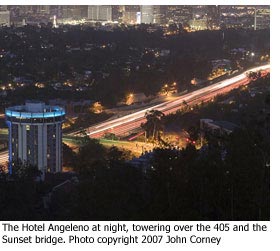 Demolition work on the Sunset Bridge over the 405 Freeway will take place within a massive cocoon of sound blankets—some 30 feet long and suspended from cranes. Others will be draped from the back side of the bridge, while additional blankets will encase concrete barriers around the site as the south side of the bridge is dismantled piece by piece on six consecutive nights.
Demolition work on the Sunset Bridge over the 405 Freeway will take place within a massive cocoon of sound blankets—some 30 feet long and suspended from cranes. Others will be draped from the back side of the bridge, while additional blankets will encase concrete barriers around the site as the south side of the bridge is dismantled piece by piece on six consecutive nights.
The sound absorption blankets—all 6,000 square feet of them—are a bit of “pre-emptive mitigation” that officials hope will help muffle some of the expected noise from the project, which, after weeks of prep work, is about to enter the bridge demolition phase on July 23.
“We’re basically encircling the site with sound blankets,” says Devon Cichoski, Metro’s community relations manager on the project to add a 10-mile northbound carpool lane to the 405 Freeway, along with other improvements. “The idea is you kind of encase the bridge in these sound blankets and less noise is escaping into the community.”
Nighttime construction noise is allowed up to 86 decibels, as measured 50 feet from the site.
“Could it still be loud with all that stuff up? Absolutely,” Cichoski says.
So people with urgent noise complaints—or other emergency issues—are encouraged to call the project’s hotline number, (213) 922-3665.
Operators (well, Metro community relations staff) really will be standing by, Cichoski says. After-hours callers will be connected to a line that provides the cell phone number of that night’s on-call representative. Callers with more routine comments or questions can leave a message. The hotline also offers a recorded rundown on each day’s lane and ramp closures.
For a look at all the planned freeways and street closures—and recommended detours—during the Sunset Bridge demolition work, check out this construction notice and attached map.
The Sunset Bridge is the first of three bridges over the freeway that will be demolished in sections and reconstructed in new-and-improved form during the course of the project. (The others are at Skirball Center Drive and Mulholland Drive.)
After the south side of the Sunset Bridge is rebuilt—which should take about 10 months—the process will be repeated on the north side. The bridge will have four lanes open to traffic during construction—two in each direction.
Read our earlier story about the Sunset Bridge work here.
405 project questions? Ask away
May 17, 2010
If the prospect of three years of construction on the 405 Freeway has you concerned, curious, or both, here’s a chance to get some answers about the project directly from the man in charge.
Metro’s Mike Barbour, who’s heading up the effort to build a 10-mile northbound carpool lane through the Sepulveda Pass, will be answering questions during an online chat on Wednesday, May 26 from noon to 1 p.m.
The session is called “Living with the I-405 Sepulveda Pass Widening Project.” Metro asks that you submit your questions in advance, and says queries under 300 characters will get priority during the session.
Full information on the session is here, along with a project overview in which Barbour says that widening and improving the freeway—one of the nation’s busiest—is as “challenging as performing heart surgery on a patient while she runs a marathon.” The job’s expected to be completed by 2013.
Posted 5-17-10
Demolition time on Sunset
May 5, 2010
When the Sunset Boulevard bridge overpass to the 405 Freeway comes down, don’t expect a Vegas-style, imploding-the-Sands-Hotel kind of spectacle. This will be more of a chunk-by-chunk demolition—what one Metro official likens to taking apart a giant Lego structure.
But this is no child’s play.
The $1.034 billion I-405 Sepulveda Pass widening project enters a challenging new phase this week as workers prepare to demolish portions of the Sunset Bridge, one of three overpasses to be taken down and replaced with wider, upgraded structures in coming months. Up next are bridges at Skirball Center Drive (work slated to begin this fall) and Mulholland (scheduled to begin after the Skirball work starts.)
Although advance work on the Sunset bridge project starts Friday, the precise date for the demolition is up in the air, with the start likely to come this month, depending on how the prep work goes.
The bridge will have four lanes open to traffic during construction—two in each direction—but the prospect of the inevitable noise, dirt and traffic disruption has many in this tony neighborhood on edge. Adding to the concern is the beginning of work next week on a city Department of Water and Power water pipeline project that, for the next six months, will close a block-long stretch of Church Lane heading south from Sunset.
At the Luxe Hotel Sunset Boulevard, one of two upscale hotels located in the midst of the coming action, employees are used to staging enormous wedding and bar mitzvah receptions in the 300-guest ballroom and catering to the needs of high-profile guests reported to include celebrities such as Charlize Theron and Jennifer Love Hewitt.
But operating a hotel with two massive construction projects just outside the door?
“We are actually, honestly, scared,” says Seth Horowitz, who until recently was general manager of the Luxe, site of a community meeting earlier this week for members of local neighborhood associations seeking information on the projects. Metro representatives have met with officials of the Luxe and its nearby counterpart, Hotel Angeleno, and promised to stay in close communication to ensure that construction doesn’t interfere with upcoming big events at the hotels.
Even at the best of times, getting around the area can be tough. Horowitz said a guest at a “very important event” recently told him about battling rush hour traffic for 1-1/2 hours to reach the hotel from Paul Revere Middle School near Mandeville Canyon Road—less than three miles away. “That’s before they cut down the bridge,” Horowitz says.
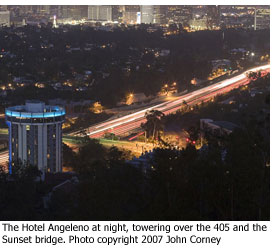 Eventually, that kind of surface street congestion should be helped by the freeway project, whose primary objective is to create a 10-mile northbound carpool lane on the 405 through the Sepulveda Pass—one of the most heavily-traveled corridors in the country. The rebuilt Sunset Bridge will be upgraded seismically and will be wider—120 feet, compared to 90 feet now—with 8 lanes instead of the current six and “higher capacity on- and off-ramps,” according to Metro.
Eventually, that kind of surface street congestion should be helped by the freeway project, whose primary objective is to create a 10-mile northbound carpool lane on the 405 through the Sepulveda Pass—one of the most heavily-traveled corridors in the country. The rebuilt Sunset Bridge will be upgraded seismically and will be wider—120 feet, compared to 90 feet now—with 8 lanes instead of the current six and “higher capacity on- and off-ramps,” according to Metro.
The new capacity could also help with concerns about freeway-bound cars backing up onto local streets. As for the long-running issue of freeway-ramp meter timing, a pilot program set to begin May 21 will examine whether turning the meters off during construction will improve traffic conditions.
Mike Barbour, Metro’s top executive on the project, acknowledges the area’s traffic congestion problems and the fact that residents will “kind of have to plan their lives around this work” for a while.” He says his agency is working to communicate alternative routes and detours, and to respond, whenever possible, to community suggestions for improving the situation. “If it becomes a complete mess out there,” he says, “obviously we’re going to correct that.”
More than anything, though, he says the goal is to get the contractor, Kiewit Pacific Co., to complete the work as quickly as possible. “Our big push is going to be to get it done sooner,” Barbour says.
In the meantime Metro has established a page dedicated to the Sunset Bridge demolition on its website and also is experimenting with an array of social media to get the word out. “I tweeted 14 times today, just because today there happened to be a lot of lane closures,” says Ned J. Racine, the project’s “new media officer.” In addition to Twitter and Facebook, the latest tool in Racine’s lineup is Nixle, an ad-free notification site used by law enforcement and other government agencies to communicate highly localized information to members of the public.
But cyber tools are not going to be enough to get the job done in the real world, even in this highly desirable corner of the real world, dotted as it is with such internationally known locales as the Getty, UCLA, Brentwood and Bel-Air. So for the demolition work, they’re bringing in a destruction tool called the “hoe ram”—a crane with a massive jackhammer attached. The contractor is “basically going to break the bridge apart with a huge jackhammer,” says Mark Van Gessel, Metro’s manager for the Sunset segment.
The work will take place in phases—between 6 and 9 nights of demolition followed by 10 months of construction on the southern end of the bridge, with a repeat of the same pattern on the northern side when the first half is finished. In all, some 12,000 tons of concrete will come down, to be pulverized onsite and recycled as “crushed miscellaneous base” and used as a building material on the project.
Segments of the freeway will be closed when demo work is taking place on the bridge overhead, as will streets including Sunset and Sepulveda. However, the work will be staggered so that the freeway and Sepulveda will not be closed at the same time.
Workers will start preparing for the job on Friday night, closing Sunset Boulevard and on-ramps near the Hotel Angeleno at 9 p.m. to establish new lane markings and a work zone to be completed by 6 a.m. Monday morning. Then they’ll start preparing the bridge for demolition: securing a major 34-inch water line inside the bridge; removing and bagging asbestos from around piping; and taking out the original wood forms so that the concrete can be recycled.
Cori Solomon, president of the Brentwood Glen Association, organized the meeting at the Luxe Hotel this week and invited her counterparts in the Westwood Hills Residents Association to take part as well. (Metro’s presentation is here, with slide 11 detailing Friday’s work.)
About 200 people showed up to voice concerns about noise, the double-whammy of the Church Lane water main work taking place at the same time the bridge job is underway, and the potential for construction to send new “cut through” traffic onto traditionally quiet residential streets.
Solomon, who’s lived in the neighborhood nearly 24 years, says her goal throughout the project is to “keep the community aware” and to find ways to make the situation “semi-livable” for residents.
“The board understands that it’s not going to be easy. It’s going to be a mess,” she says. “The thing is, it’s going to happen. You can’t stop it.”
And a philosophical attitude helps. “In the scheme of things, this freeway construction is a small speck in your life,” Solomon says. “In the end, it will hopefully be a little better, a little nicer.”
The project hotline number is (213) 922-3665. The next community meeting is scheduled for May 20, from 6-8 p.m. at The Getty. A fact sheet on the project, including a list of frequently asked questions, is here.
Posted 5-05-10
What’s up with the 405 project?
February 18, 2010
A community meeting has been scheduled for Tuesday, Feb. 23, to provide updates on the project to add a carpool lane to the northbound 405 through the Sepulveda Pass.
Learn how the work is going—despite a series of rain delays just as work began—and find out what’s coming next.
The meeting will be held at The Getty, from 6-8 p.m. Full details are here.
Posted 2/18/10
Meet Metro’s man on the 405 project
January 12, 2010
It wasn’t that long ago that Mike Barbour was in the midst of rocket attacks as an Air Force reservist working on projects like rebuilding bombed out bridges or constructing temporary aircraft hangars in Iraq.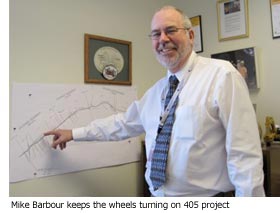
Now he’s under another kind of pressure, of the diplomatic and logistical variety, as Metro’s top guy on the 405 Sepulveda Pass widening project—a multi-jurisdictional, three-year undertaking that will create a 10-mile northbound carpool lane between the Santa Monica (10) and the Ventura (101) freeways.
Along the way, it will have a profound impact on commuters traveling one of the nation’s most heavily traveled freeways, and also will significantly affect the surrounding neighborhoods and businesses. It’s a huge job that requires deft coordination among agencies and departments and a straight-shooting approach to communicating with the area’s well-informed–and often vocal–residents.
Enter Mike Barbour.
Barbour, 56, who joined Metro just a year ago, figures it was his unique set of highway design and construction experiences—and not his time in a war zone—that made him the right man for the job of overseeing every facet of the complex project.
Still, it couldn’t hurt.
At his first meeting with representatives of homeowner groups, he encountered a contentious crowd but ended up making a positive impression.
“He kept his cool,” says Milton Miller, past president of the Bel-Air Association and the homeowner group’s representative on the Community Advisory Committee that is working with Metro on the 405 project. “He acted like a gentleman. He seems calm and measured, and pays attention. My impressions are positive. He didn’t try to hog the presentation and say, ‘This is about me.’”
Now, as eight weeks of night work begin on the 405, setting the stage for construction to begin in earnest in March, Barbour finds himself at the center of a high profile and high stakes enterprise that will be closely watched across the region.
The inaugural construction phase will change life as we know it on the already congested 405. “It’s a big deal…The people that drive this, that live there, haven’t been impacted and now they’re going to be impacted.”
The impact hits on Wednesday, Jan. 13, at 7 p.m., when, weather permitting, crews will start delineating new, narrower lanes on the freeway to accommodate a construction zone.
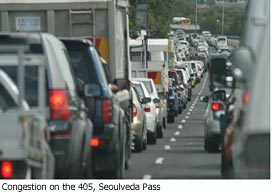 The first full freeway closure is set to occur after midnight, in the early morning hours of Jan. 14, with all lanes scheduled to reopen by 6 a.m. [Updated 1/13/10: The start of work on the 405 is being delayed for a second night because of rain. Learn more here.] Updates also are being posted on Twitter. In addition, Metro has expanded its community relations staff on the project and has established a hotline for public inquiries, (213) 922-3665.
The first full freeway closure is set to occur after midnight, in the early morning hours of Jan. 14, with all lanes scheduled to reopen by 6 a.m. [Updated 1/13/10: The start of work on the 405 is being delayed for a second night because of rain. Learn more here.] Updates also are being posted on Twitter. In addition, Metro has expanded its community relations staff on the project and has established a hotline for public inquiries, (213) 922-3665.
In dealing with the community, Barbour says, the important thing is to stick to the facts in the project plan. “All the people on the Westside understand what’s going on,” he says. “You need to be very straightforward.”
At monthly meetings with the Community Advisory Committee, Barbour says he tackles “every issue under the sun,” including such questions as: “Are you closing my off ramp? Are you affecting me? Can emergency equipment get through?” (For that last question, he brought in police and fire representatives to explain how they will respond.)
There are also meetings for the community as a whole, such as an open house planned for Jan. 20 at the Westwood Recreation Center.
The project, a partnership of the Los Angeles Metropolitan Transportation Authority (Metro) and the California Department of Transportation (Caltrans), is expected to cost $1.034 billion, with $189.9 million coming from the American Recovery & Reinvestment Act of 2009. The rest will flow from state and other federal sources.
Barbour’s job, which pays $200,000 annually, involves coordinating the work of all agencies with a role in the project—including Caltrans, the city Department of Transportation and L.A. County.
“It’s really trying to knock down the barriers for the contractor (Kiewit Pacific Co.),” says Barbour, whose official title is Executive Officer, Highway Project Management. “One of our main concerns is keeping the project on schedule.”
He’s a true believer in the importance of completing the northbound carpool lane through the Sepulveda Pass and creating an unbroken high-occupancy vehicle route from the Orange County line north to the San Fernando Valley.
“The HOV lane is a really big impact,” he says. “Three hundred thousand people come through there daily.”
Metro estimates that daily carpool commuters could save about 10 minutes a day—50 minutes a week—when the project is completed in 2013. “It’s not a lot for an individual,” Barbour says, “but for 300,000 people—that’s a significant amount of money and time.”
Carpool lanes aren’t just a job for Barbour; they’re a passion.
He says he often grabs a colleague to travel with him so he can take advantage of the carpool lanes on the 105 or 405 as he shuttles between his main office at the Howard Hughes Center near the airport, the job site in Brentwood and Metro’s downtown Los Angeles offices. And when he’s in the carpool lane, “I can just blow by everybody on the 105.” (Get it? He likes carpool lanes.)
Before joining Metro, Barbour, who grew up in Southern California, worked for 8 years as a consultant in the private sector. Earlier, he put in 18 years at Caltrans, including a stint as acting deputy director for design for District 7, which includes Los Angeles and Ventura counties.
If you’ve ever been on the 110/Adams Boulevard HOV lane near downtown Los Angeles, or the Carquinez suspension bridge in Northern California, you know his work.
Before Barbour retired as a major in the Air Force Reserve, he was deployed twice to Iraq—in 2003 and again in 2007. “I wouldn’t trade it for anything,” he says.
Barbour still has a home in Northern California, where he spent much of his career with Caltrans and where his wife works as an attorney. He says he’s looking to buy a place in L.A. soon.
Meanwhile, he’s got lots of 10- and 12-hour days to keep the gears moving on the 405 project. “Everybody wants to get a greener planet,” he says. “But what we’re stuck with is a society where everybody commutes. If you have it, you’ve gotta fix it.”
Posted 1/12/10
—————————————————————————————————————————————–




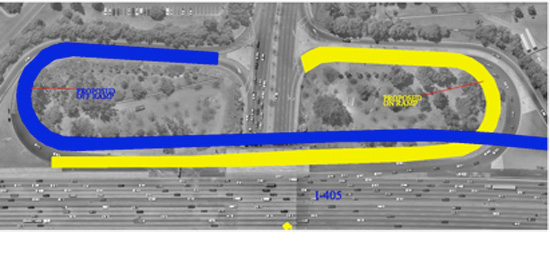
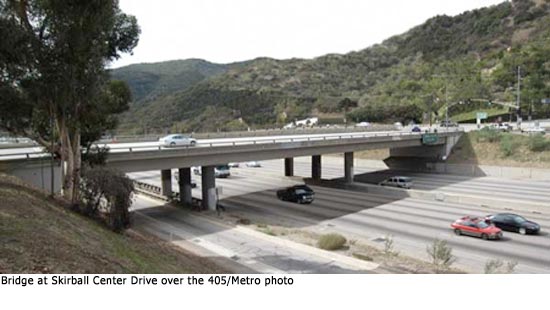
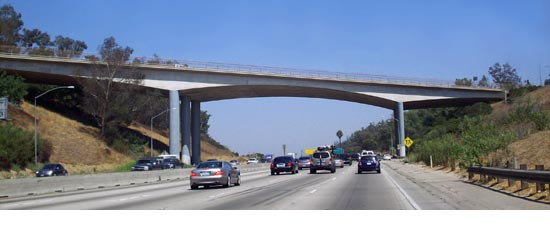
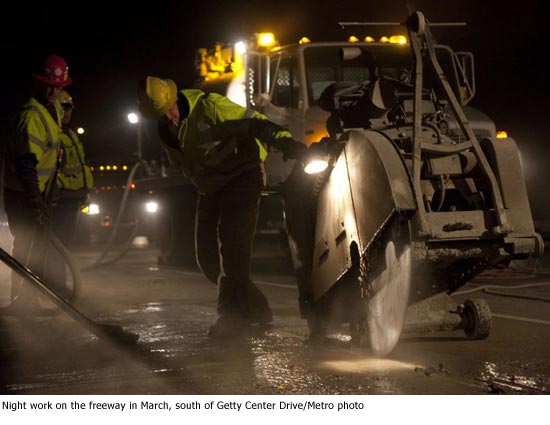
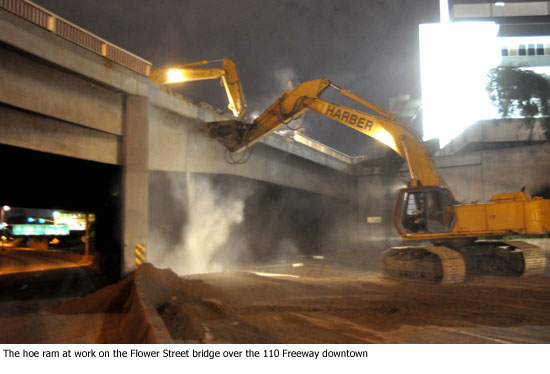
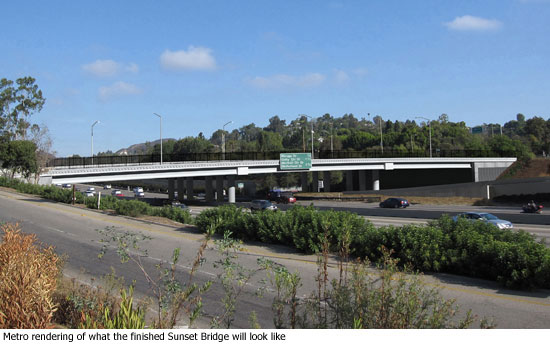
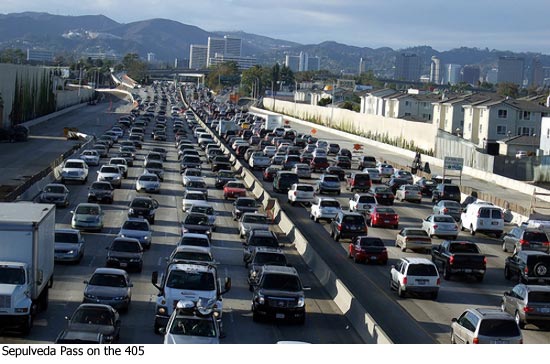
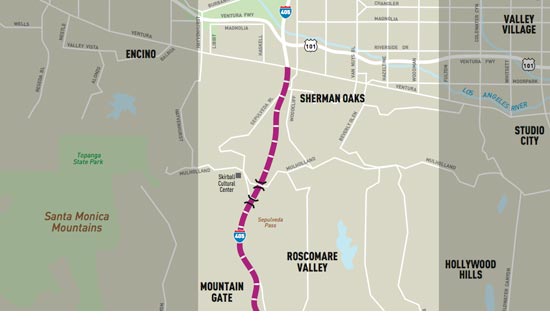







 405 bridge work causes a stink
405 bridge work causes a stink

